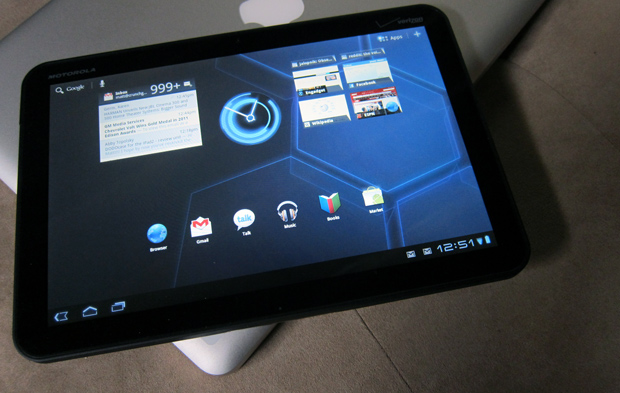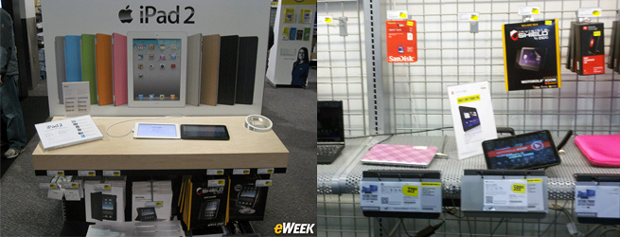
Here’s a fun tidbit for you: I really like the Motorola Xoom. The web browsing is fantastic, email is great, the notification bar is tops and, well, Verizon’s service rocks. It’s tad pricey but in my mind it’s still a great tablet. Is it better than an iPad? Well, not really, but it scores major bonus points for advancing the user experience of a tablet thanks to Google’s Honeycomb.
However, it doesn’t matter what I think. Apparently it’s not selling well with early estimates putting the Xoom’s sales numbers around 100,000. That’s about how many iPad 2s sold the first couple minutes it was available. The whole thing just smells of failure from all angles. This wasn’t just one man’s fault. Everyone had a hand on pushing the Xoom over the edge and into the barren world of niche gadgets. So who killed the Xoom? Everyone.
Google Killed The Xoom

For all Google’s talk of openness, Android has been a surprisingly closed system. Manufacturers – if they want to stay on Google’s good side – have to release devices in lock-step to Google’s release cycle. Xoom came out early – Motorola beat the pack in terms of Honeycomb availability – but why? Simply because Google gave Motorola the nod and allowed them, in no uncertain terms, to be the guinea pig for the new platform.
Motorola ran with the chance but the Xoom just wasn’t the Google dream device everyone was expecting. Google will mete out further updates with care and precision and the Xoom, first out of the gate, is already in last place when it comes to specs and potential.
Motorola Killed The Xoom
The Xoom was hyped to iPad-killer levels. Motorola teased the Internet and then finally debuted it with much fanfare at CES 2011. Then Motorola dropped the ball by taking a Droid market approach for the general consumer outreach. The Xoom’s debut commercial aired during the Superbowl and focused more on jabbing at Apple fanboys than showing off the device. Samsung had the right idea with the Galaxy Tab. Just show what the thing can do and how it will fit into daily life.
The campaign was much like what Moto did with the Droid. Smartphones are different. Most consumers understand why they should want a smartphone. That’s not the case with a tablet.
Then it was Verizon’s turn and they followed the same Droid-ish marketing scheme with a dark theme and slick CGI. It’s a great approach for people that already know about the Xoom, but a piss-poor general education campaign.
The Xoom needed — and still needs — a marketing strategy much like the iPad’s. Show the multitasking and how it makes using the Xoom easier than an iPad. Show the tabs in the browser and the speed of Verizon. Show the cameras, the awesome notification bar, the multiple homescreens, the widgets, the charging docks, just show the damn tablet. And enough with the dark and evil theme. No likes a bad guy.
Retailers Killed The Xoom

Try finding the Xoom in Best Buy. It’s not on an endcap and it’s not in the new tablet section located in the mobile department. There are no signs pointing it out. It’s just stuck in with the netbooks, sitting there like an under-appreciated tween in gym class. And they wonder why no one is buying it. There is nothing calling consumers away from the blindingly white iPad display.
Part of this is on Motorola for clearly not setting up the proper distribution deal with the country’s major electronic retailer. The Xoom was supposed to be a hot seller. It was supposed to offer iPad buyers an out from Apple’s walled garden. No one knows it exists because retailers haven’t put on a Xoom dog and pony show.
The bean counters could be to blame for poor placement. Of course this is just me speculating based on six years of Circuit City experience, but profitable products are generally given more visible shelf space than low margin products. For instance people that buy iPads tend to buy accessories. And there are a lot of iPad accessories. Plus, Apple is the king of keeping manufacturing costs low, which often results in higher profit margins that are generally passed on to retailers. The Xoom likely doesn’t have a cushy profitability level, which makes it take a backseat to those products that actually make money.
Whatever the case happens to be, retailers haven’t given the Xoom the attention it needed to sell en masse. Sad.
I’ll say it again: I really like the Xoom and fully believe the sales numbers do not convey the product’s quality. That said, no Android tablet should be expected to sell in significant enough numbers to stand up to the iPad like Android did to the iPhone. Every tablet besides the iPad will be a niche product until the form factor is as accepted as the smartphone. Android fanboys, this is going to be hard to admit, but the iPad is the only tablet up to the task.